Shear Behavior and Design of Innovative Stud-Reinforced Embedded Shear Connectors with Flanges
Abstract
1. Introduction
2. Experimental Program
2.1. Specimen Design
2.2. Test Setup and Instrumentation
3. Experimental Results and Discussion
3.1. Failure Modes
3.2. Parametric Study
3.2.1. Effect of the Width-to-Thickness Ratio of the Steel Flange
3.2.2. Effect of the Embedding Depth of the Web
3.2.3. Effect of the Reinforcing Studs
3.2.4. Effect of the Thickness of the Web
3.2.5. Effect of the Diameter of the Combined Rebar
4. Theoretical Calculation of Shear Capacity of the SR-ESCF
5. Finite Element Analysis and Optimization
5.1. Element Type and Meshing
5.2. Material Properties
5.3. Interaction and Boundary Conditions
5.4. Verification of the FEM
5.5. Optimization of the Shear Capacity of the Connector
6. Concluding Remarks
- According to the push-out tests, the failure modes of the SR-ESCF are mainly controlled by local buckling and the splitting of the concrete, which were characterized as the local buckling of flange around the welded stud and the cracks developing along the corrugated web on the concrete slab, respectively.
- With the studs welded at the flange, the SR-ESCF exhibited larger shear stiffness and shear capacity than the ESCF, which were increased by 17% and 15%, respectively. Moreover, the head studs prevented local buckling of the steel flange. The number of the studs should be adjusted to enhance the shear capability when the SR-ESCF is designed with a thin steel flange.
- According to the parametric analysis, the reinforcing stud, the embedding depth of web, and the width-to-thickness ratio of the flange have a significant effect on the shear strength of the SR-ESCF. However, the thickness of web and the diameter of combined rebar have a negligible effect. The proposed design formula for the shear capacity of the SR-ESCF is consistent with the test results, with the mean value of the predicted results to test results ratio and the variation coefficient being 0.87 and 0.13, respectively. However, the proposed equation was only validated by limited test data, and further validations are still necessary.
- The result of FEM including the ultimate shear strength, failure modes, and load–slip curves were good with the push-out test results. Moreover, the shear capacity of the connector was increased by about 15% by optimizing the layout of the studs. The reinforcing studs exhibited a great impact on the failure mode and shear capacity of the SR-ESCF, which changed the failure mode of the SR-ESCF from local buckling to concrete-splitting crack.
Author Contributions
Funding
Data Availability Statement
Conflicts of Interest
References
- Deng, W.; Liu, D.; Xiong, Y.; Zhang, J. Experimental study on asynchronous construction for composite bridges with corrugated steel webs. J. Constr. Steel Res. 2019, 157, 93–102. [Google Scholar] [CrossRef]
- Huang, D.; Wei, J.; Liu, X.; Xiang, P.; Zhang, S. Experimental study on long-term performance of steel-concrete composite bridge with an assembled concrete deck. Constr. Build. Mater. 2019, 214, 606–618. [Google Scholar] [CrossRef]
- Zhou, Z.; Wang, Y.; Zhai, X. Tensile resistance of novel interlocked angle connectors used in steel-concrete-steel sandwich structures. Constr. Build. Mater. 2022, 341, 127774. [Google Scholar] [CrossRef]
- Zhuang, B.; Liu, Y. Study on the composite mechanism of large Rubber-Sleeved Stud connector. Constr. Build. Mater. 2019, 211, 869–884. [Google Scholar] [CrossRef]
- Zou, Y.; Qin, F.; Zhou, J.; Zheng, Z.; Huang, Z.; Zhang, Z. Shear behavior of a novel bearing-shear connector for prefabricated concrete decks. Constr. Build. Mater. 2021, 268, 121090. [Google Scholar] [CrossRef]
- Cui, C.; Song, L.; Liu, R.; Liu, H.; Yu, Z.; Jiang, L. Shear behavior of stud connectors in steel bridge deck and ballastless track structural systems of high-speed railways. Constr. Build. Mater. 2022, 341, 127744. [Google Scholar] [CrossRef]
- He, Y.; Guo, S.; Wang, L.; Yang, Y.; Xiang, Y. Experimental and numerical analysis of grouped stud shear connectors embedded in HFRC. Constr. Build. Mater. 2020, 242, 118197. [Google Scholar]
- Xu, X.; Zhou, X.; Liu, Y. Behavior of rubber-sleeved stud shear connectors under fatigue loading. Constr. Build. Mater. 2020, 244, 118386. [Google Scholar] [CrossRef]
- Kruszewski, D.; Wille, K.; Zaghi, A. Push-out behavior of headed shear studs welded on thin plates and embedded in UHPC. Eng. Struct. 2018, 173, 429–441. [Google Scholar] [CrossRef]
- Duan, M.; Zou, X.; Bao, Y.; Li, G.; Chen, Y.; Li, Z. Experimental investigation of headed studs in steel-ultra-high performance concrete (UHPC) composite sections. Eng. Struct. 2022, 270, 114875. [Google Scholar] [CrossRef]
- Wang, J.; Qi, J.; Tong, T.; Xu, Q.; Xiu, H. Static behavior of large stud shear connectors in steel-UHPC composite structures. Eng. Struct. 2019, 178, 534–542. [Google Scholar] [CrossRef]
- Liu, Y.; Zeng, D.; Cao, L.; Lu, N.W. Experimental Study on an Innovative Shear Connector in Steel-UHPC Composite Structure. Adv. Civil Eng. 2021, 2021, 6643291. [Google Scholar] [CrossRef]
- Hu, Y.; Yin, H.; Ding, X.; Li, S.; Wang, J. Shear behavior of large stud shear connectors embedded in ultra-high-performance concrete. Adv. Struct. Eng. 2020, 23, 3401–3414. [Google Scholar] [CrossRef]
- Deng, W.; Hu, K.; Liu, D.; Zhao, X.; Zha, S.; Zhang, J. Experimental Study and Calculation Method of Shear Capacity for Cluster Studs Connector. China J. Highw. Transp. 2022, 35, 194–204. [Google Scholar]
- Sedghi, Y.; Zandi, Y.; Shariati, M.; Ahmadi, E.; Azar, V.; Toghroli, A.; Safa, M.; Mohamad, E.; Khorami, M.; Wakil, K. Application of ANFIS technique on performance of C and L shaped angle shear connectors. Smart Struct. Syst 2018, 22, 335–340. [Google Scholar]
- Shariati, M.; Tahmasbi, F.; Mehrabi, P.; Bahadori, A.; Toghroli, A. Monotonic behavior of C and L shaped angle shear connectors within steel-concrete composite beams: An experimental investigation. Steel Compos. Struct. 2020, 35, 237–247. [Google Scholar]
- Kim, K.; Han, O.; Choi, J.; Kim, S. Hysteretic performance of stubby Y-type perfobond rib shear connectors depending on transverse rebar. Constr. Build. Mater. 2019, 200, 64–79. [Google Scholar] [CrossRef]
- Zou, Y.; Di, J.; Zhou, J.; Zhang, Z.; Li, X.; Zhang, H.; Qin, F. Shear behavior of perfobond connectors in the steel-concrete joints of hybrid bridges. J. Constr. Steel Res. 2020, 172, 106217. [Google Scholar] [CrossRef]
- Oguejiofor, E.; Hosain, M. Numerical analysis of push-out specimens with perfobond rib connectors. Comput. Struct. 1997, 62, 617–624. [Google Scholar] [CrossRef]
- Oguejiofor, E.; Hosain, M. A parametric study of perfobond rib shear connectors. Can. J. Civil Eng. 1994, 21, 614–625. [Google Scholar] [CrossRef]
- Oguejiofor, E.; Hosain, M. Tests of full-size composite beams with perfobond rib connectors. Can. J. Civil Eng. 1995, 22, 80–92. [Google Scholar] [CrossRef]
- Liu, Y.; Wang, S.; Xin, H.; Liu, Y. Evaluation on out-of-plane shear stiffness and ultimate capacity of perfobond connector. J. Constr. Steel Res. 2020, 167, 105850. [Google Scholar] [CrossRef]
- Wang, S.; He, J.; Liu, Y.; Li, C.; Xin, H. Shear capacity of a novel joint between corrugated steel web and concrete lower slab. Constr. Build. Mater. 2018, 163, 360–375. [Google Scholar] [CrossRef]
- Nemeth, G.; Jager, B.; Kovesdi, B.; Kovacs, N. Experimental investigation of steel-concrete composite push-out tests with embedded corrugated web. Adv. Struct. Eng. 2022, 25, 2332–2347. [Google Scholar] [CrossRef]
- Novak, B.; Roehm, J. The use of corrugated steel webs in bridge constructions—Load bearing behaviour of concrete dowels in combination with corrugated steel webs under longitudinal shear. Beton Stahlbetonbau 2009, 104, 562–569. [Google Scholar]
- Roehm, J.; Novak, B. Behavior of Composite Structures with Corrugated Steel Webs under Transverse Bending using Concrete Dowels. Beton Stahlbetonbau 2010, 105, 176–185. [Google Scholar]
- Kanchanadevi, A.; Ramanjaneyulu, K.; Gandhi, P. Shear resistance of embedded connection of composite girder with corrugated steel web. J. Constr. Steel Res. 2021, 187, 106994. [Google Scholar] [CrossRef]
- Cheng, C.; Wan, S.; Song, A. Experimental and numerical study on the mechanical properties of embedded double-row-pins connectors. Structures 2022, 35, 214–232. [Google Scholar] [CrossRef]
- Shi, J. Experimental Study on Shear Bearing Capacity of Embedded Connector with Flange Plate; Zhengzhou University: Zhengzhou, China, 2019. (In Chinese) [Google Scholar]
- GB/T 50081-2002; Standard for Test Methods of Mechanical Properties of Ordinary Concrete. Standards Press of China: Beijing, China, 2003. (In Chinese)
- GB/T 228-2002; Metallic Materials-Tensile Testing at Ambient Temperature. Standards Press of China: Beijing, China, 2002. (In Chinese)
- EUROCODE 4; EN 1994-1-1; Design of Composite Steel and Concrete Structures Part 1.1 General Rules and Rules for Buildings. EN: Brussels, Belgium, 2005.
- Deng, E.; Zhang, Z.; Zhang, C.; Tang, Y.; Wang, W.; Du, Z.; Gao, J. Experimental study on flexural behavior of UHPC wet joint in prefabricated multi-girder bridge. Eng. Struct. 2023, 275, 115314. [Google Scholar] [CrossRef]
- Gu, J.; Liu, D.; Deng, W.; Zhang, J. Experimental study on the shear resistance of a comb-type perfobond rib shear connector. J. Constr. Steel Res. 2019, 158, 279–289. [Google Scholar] [CrossRef]
- CJJT 272-2017; Technical Standard of Composite Girder Bridge with Corrugated Steel Webs. China Building Industry Press: Beijing, China, 2017. (In Chinese)
- Li, S.; Wan, S. Push-out test of the perforated corrugated plate shear connectors in steel-concrete composite structure. J. Chang. Univ. (Nat. Sci. Ed.) 2015, 2, 75–82. (In Chinese) [Google Scholar]
- Wan, Q.; Xue, D.; Pan, Z.; Ma, W. Nonlinear finite element analysis of multi-stud shear connectors. J. Jiangsu Univ. Sci. Technol. (Nat. Sci. Ed.) 2019, 5, 104–109. (In Chinese) [Google Scholar]
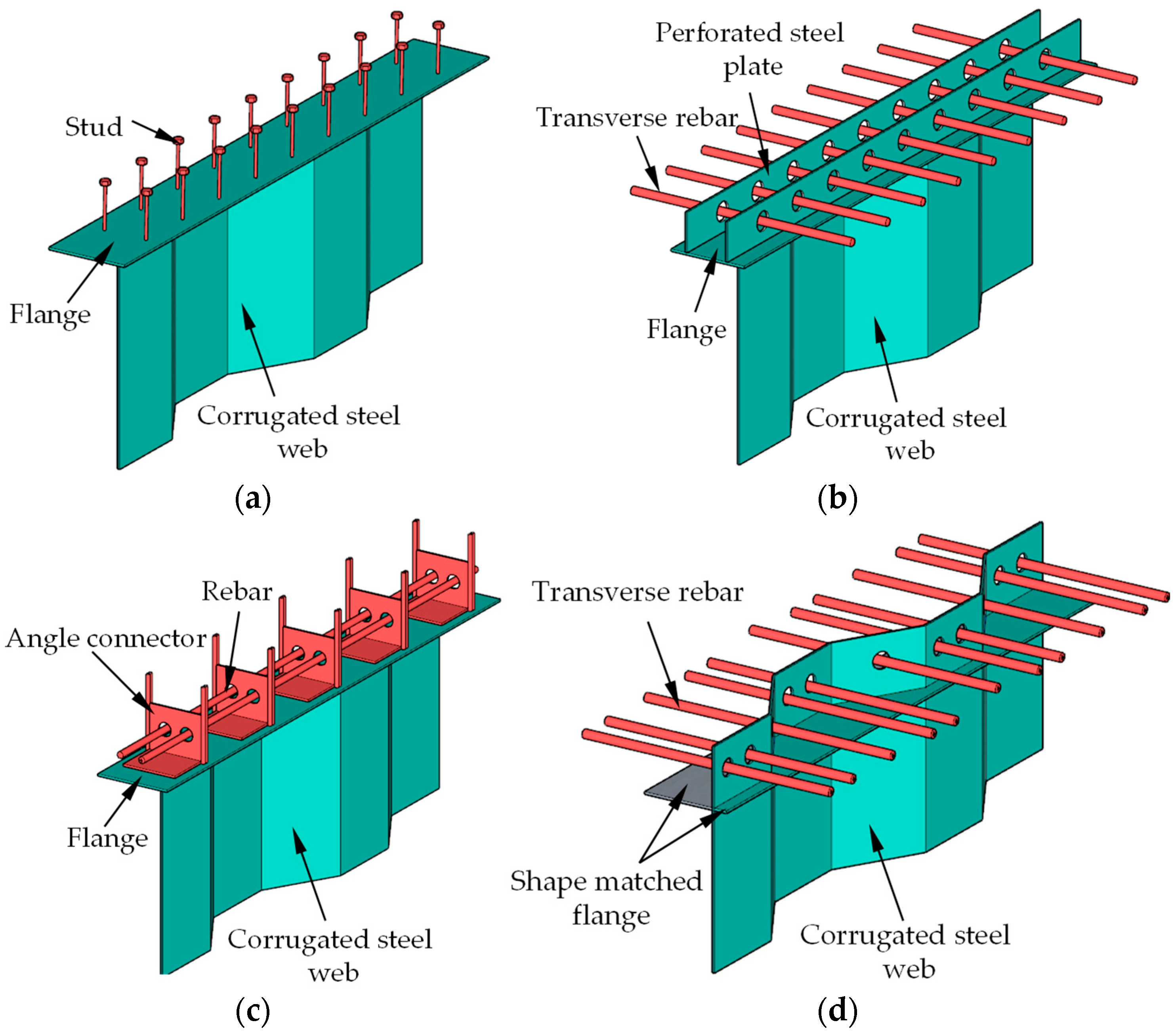
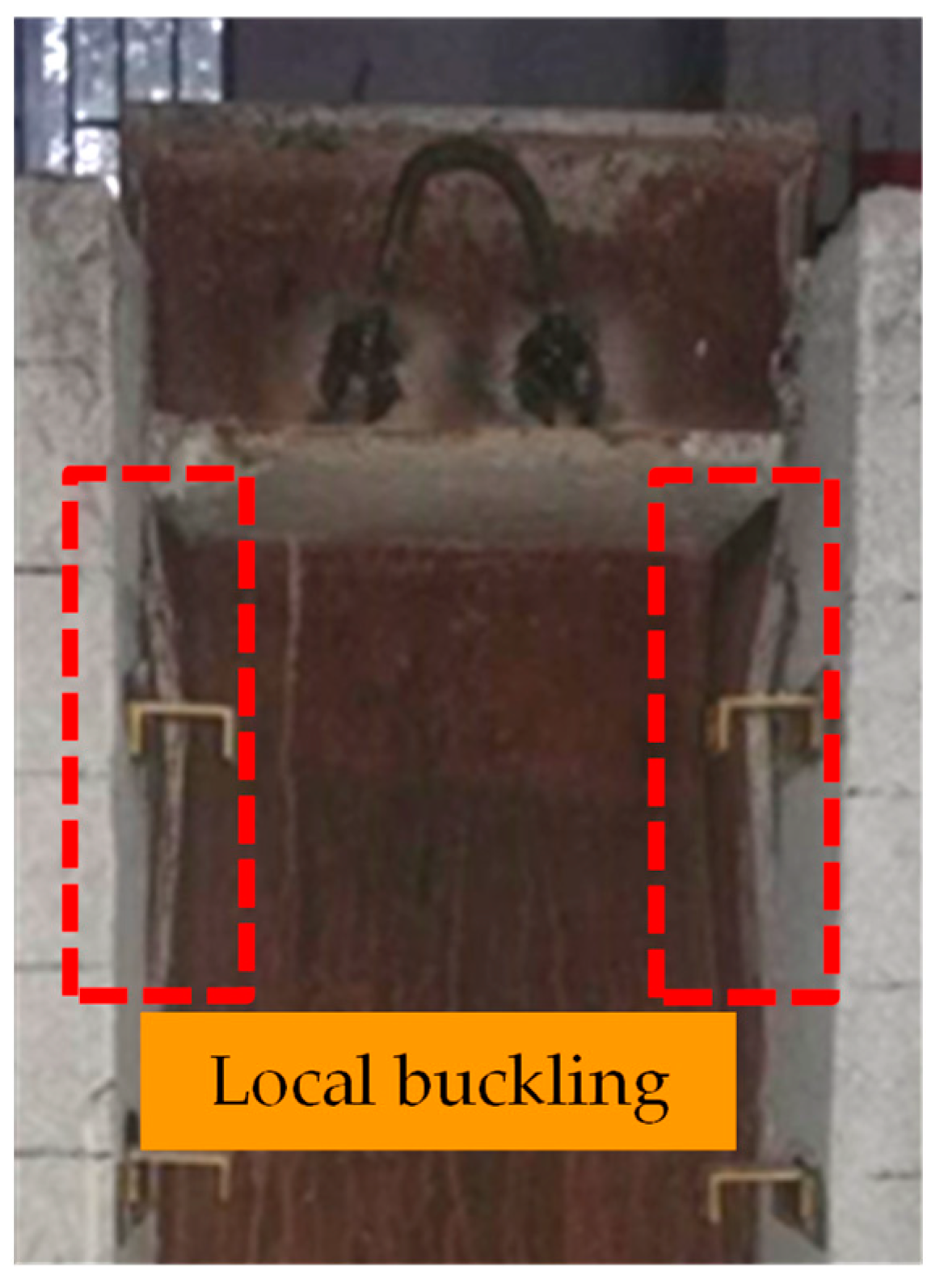

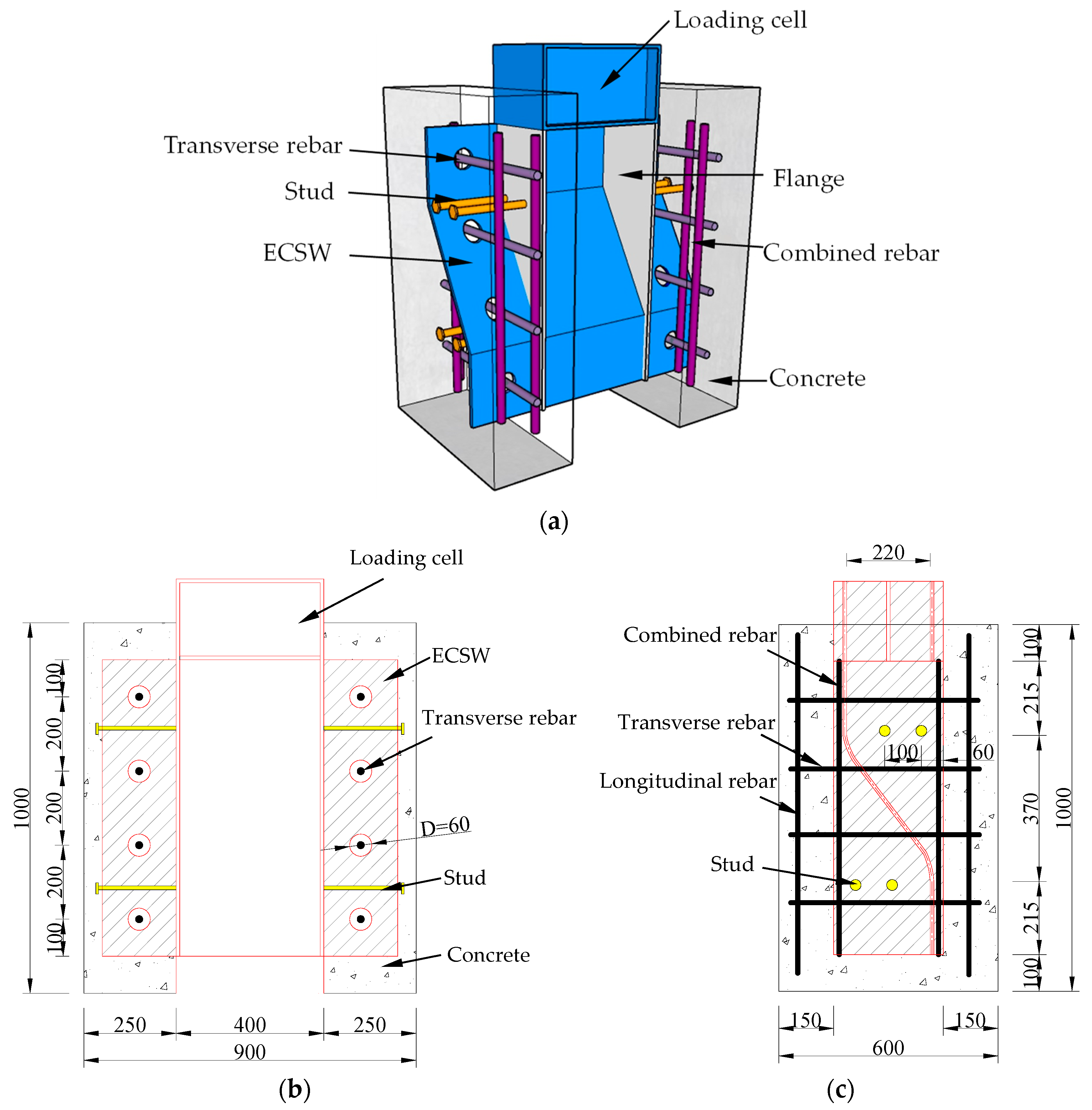
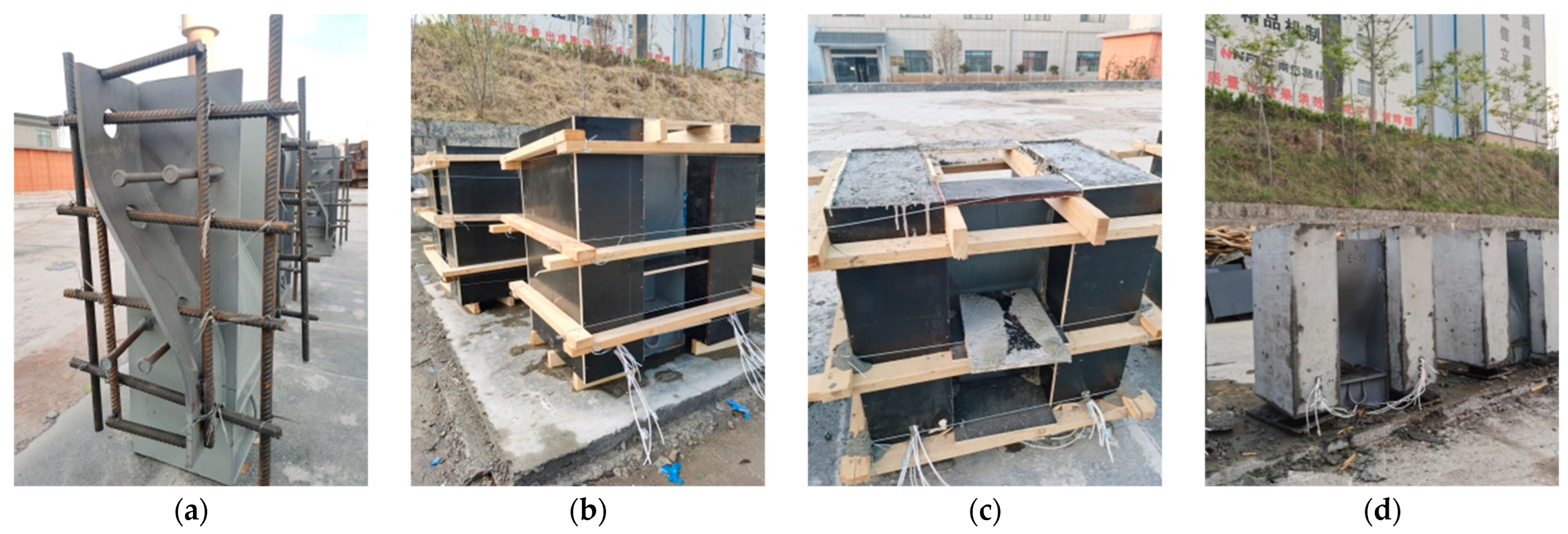
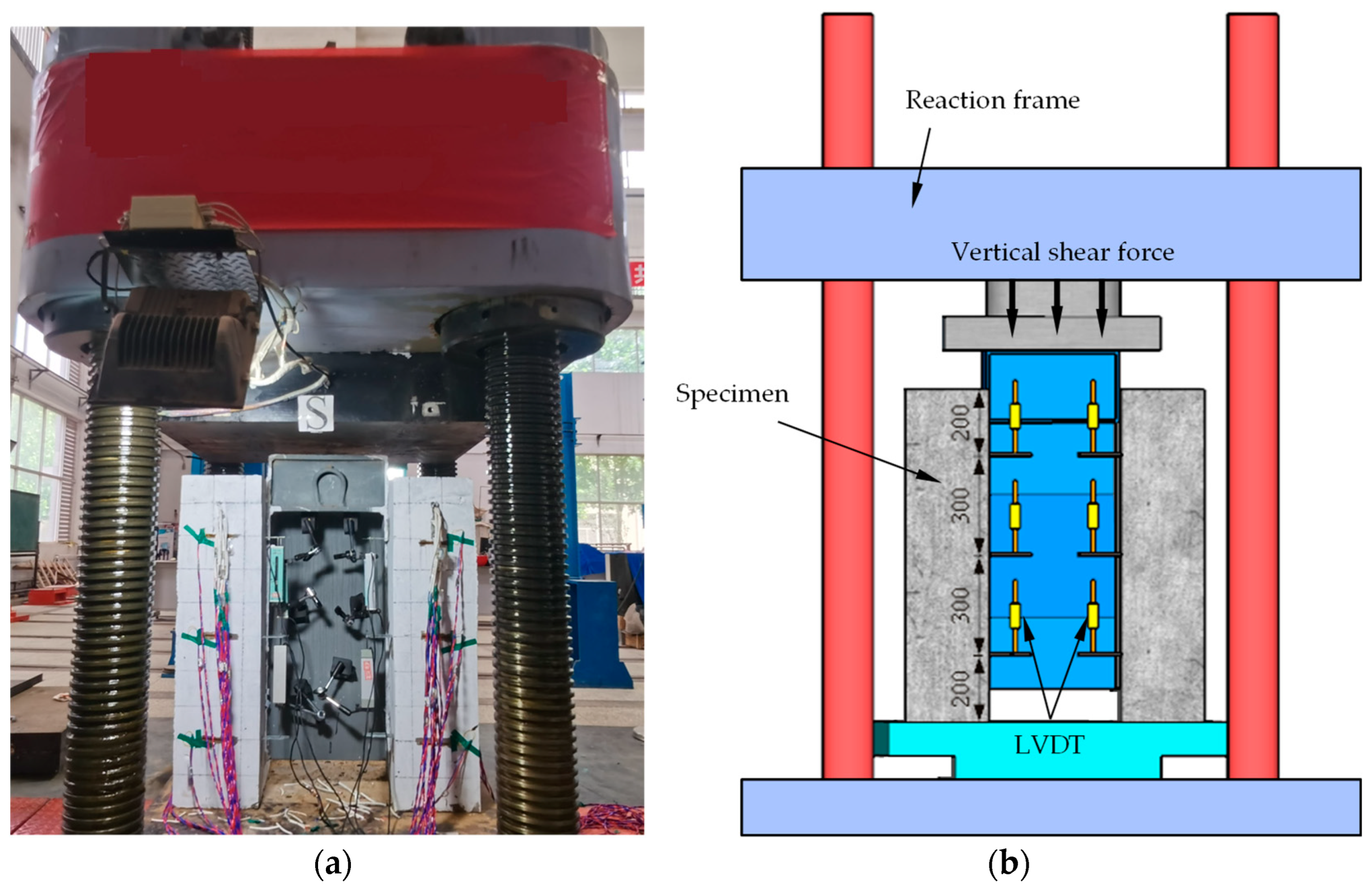

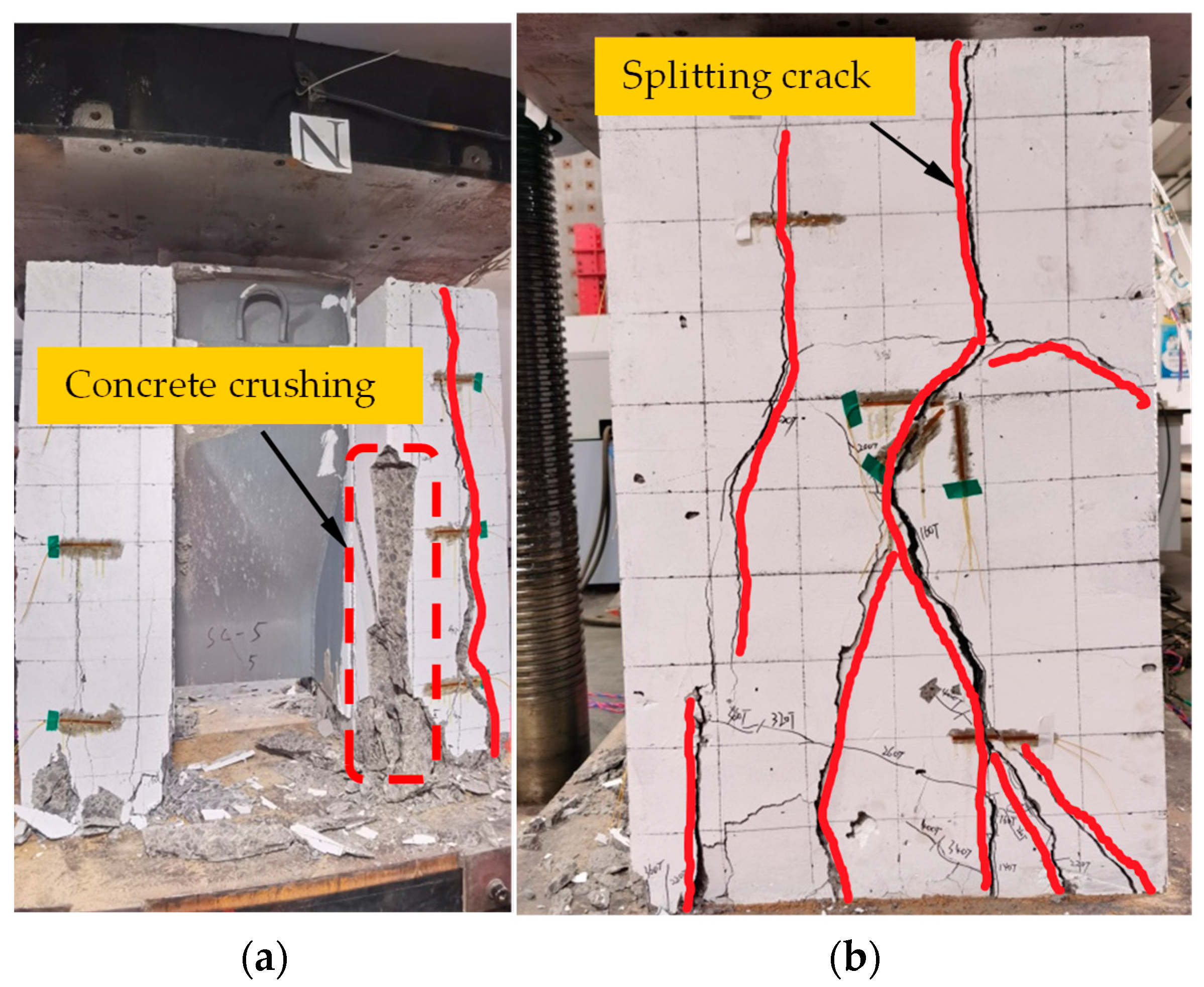

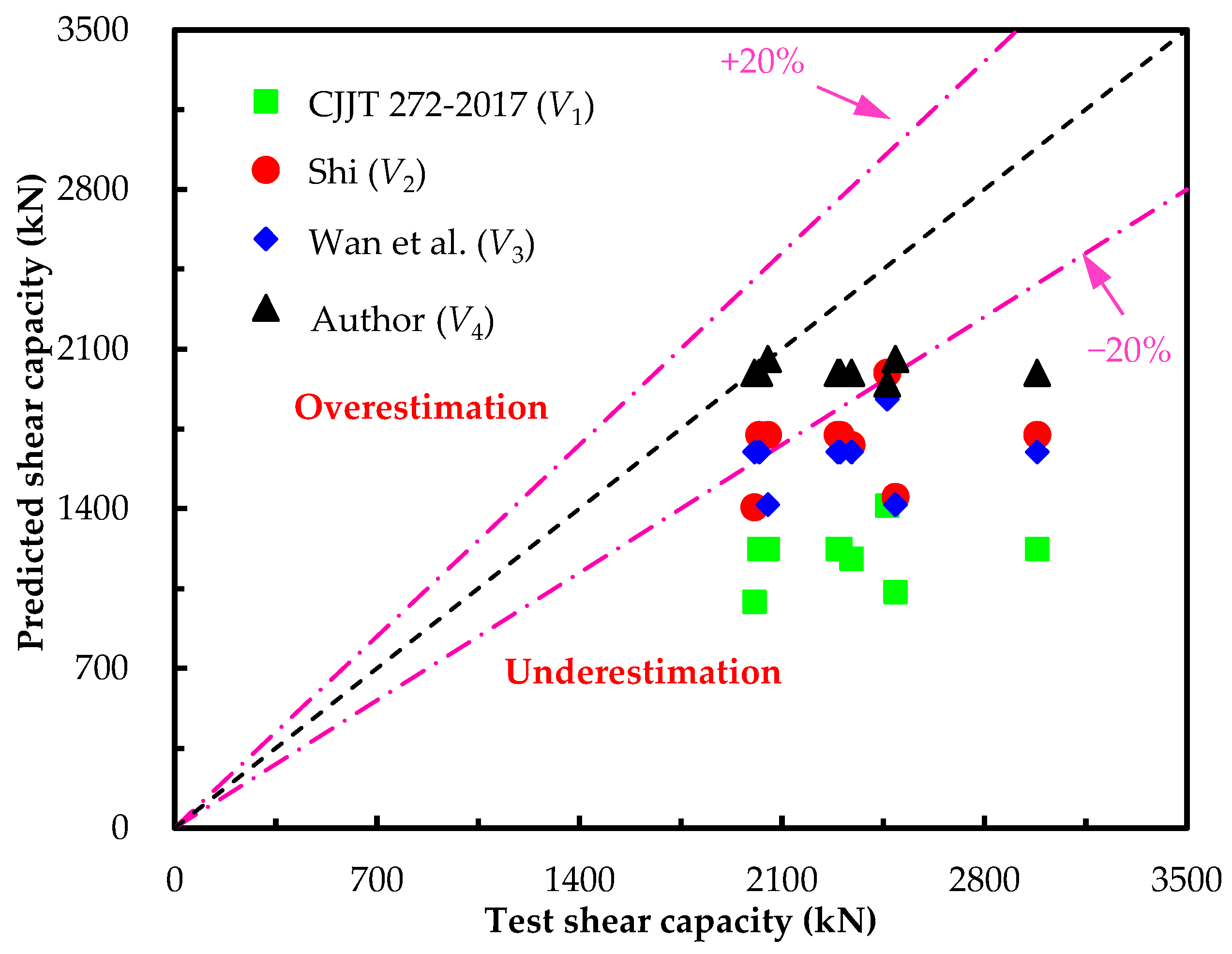

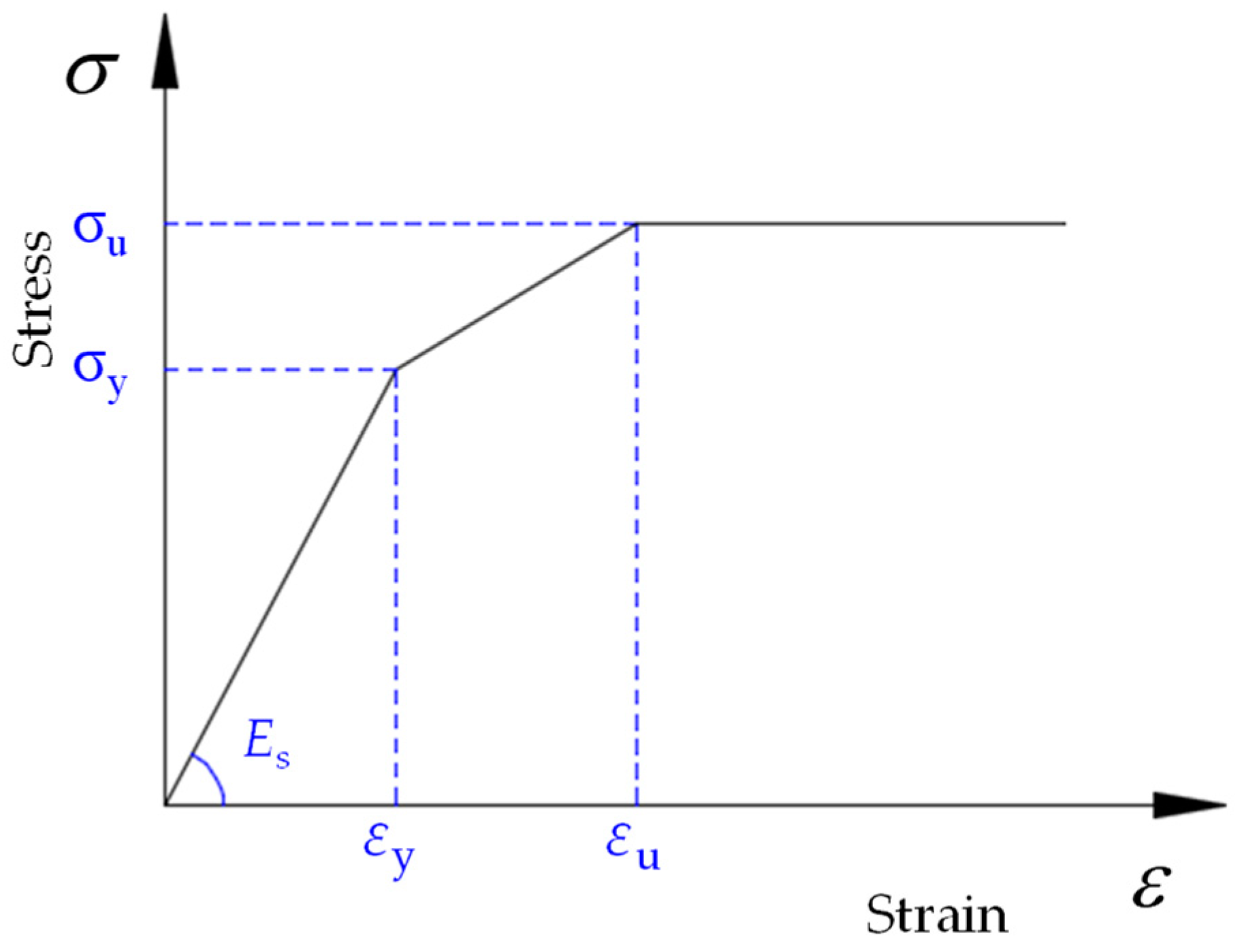
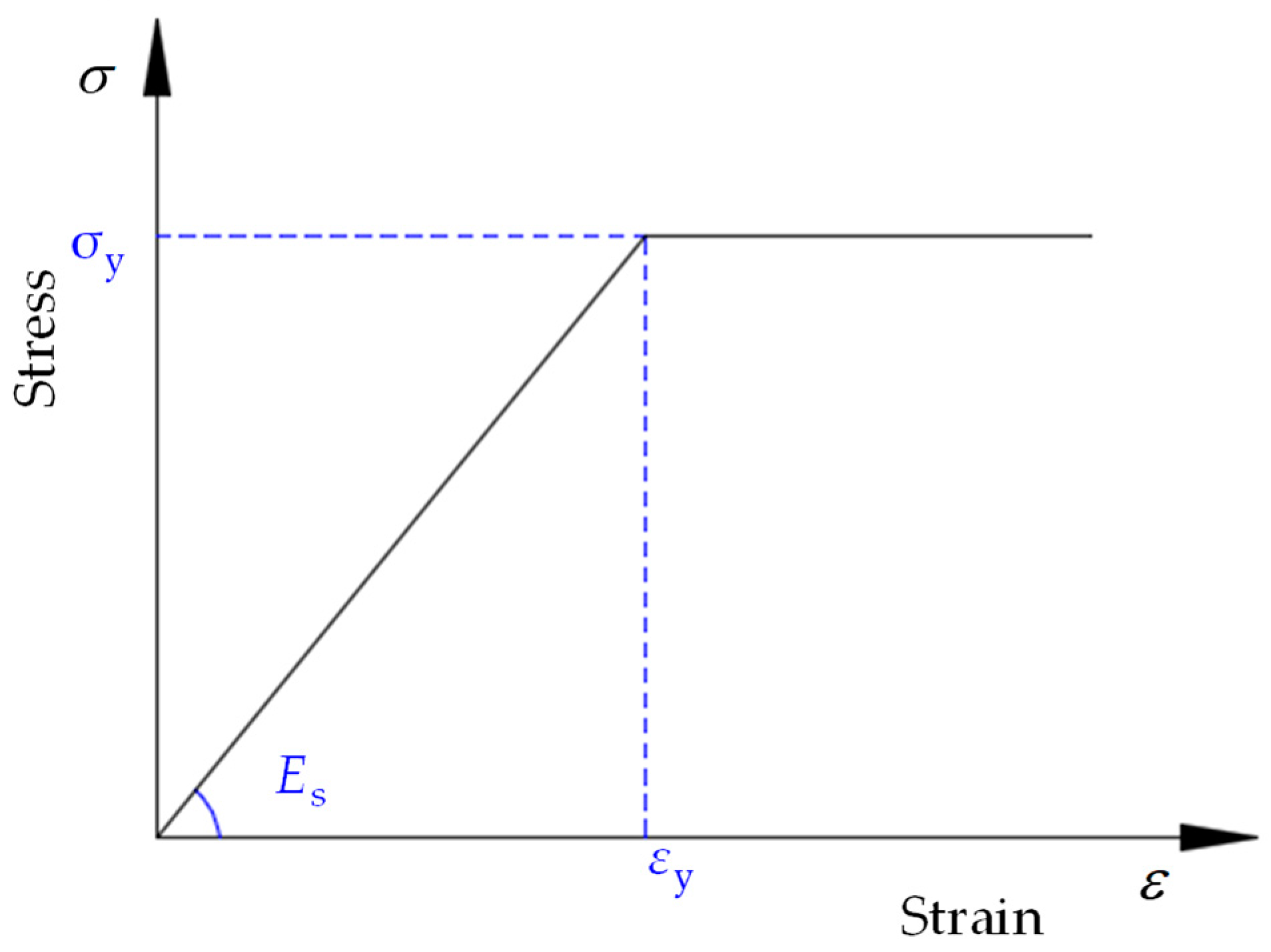
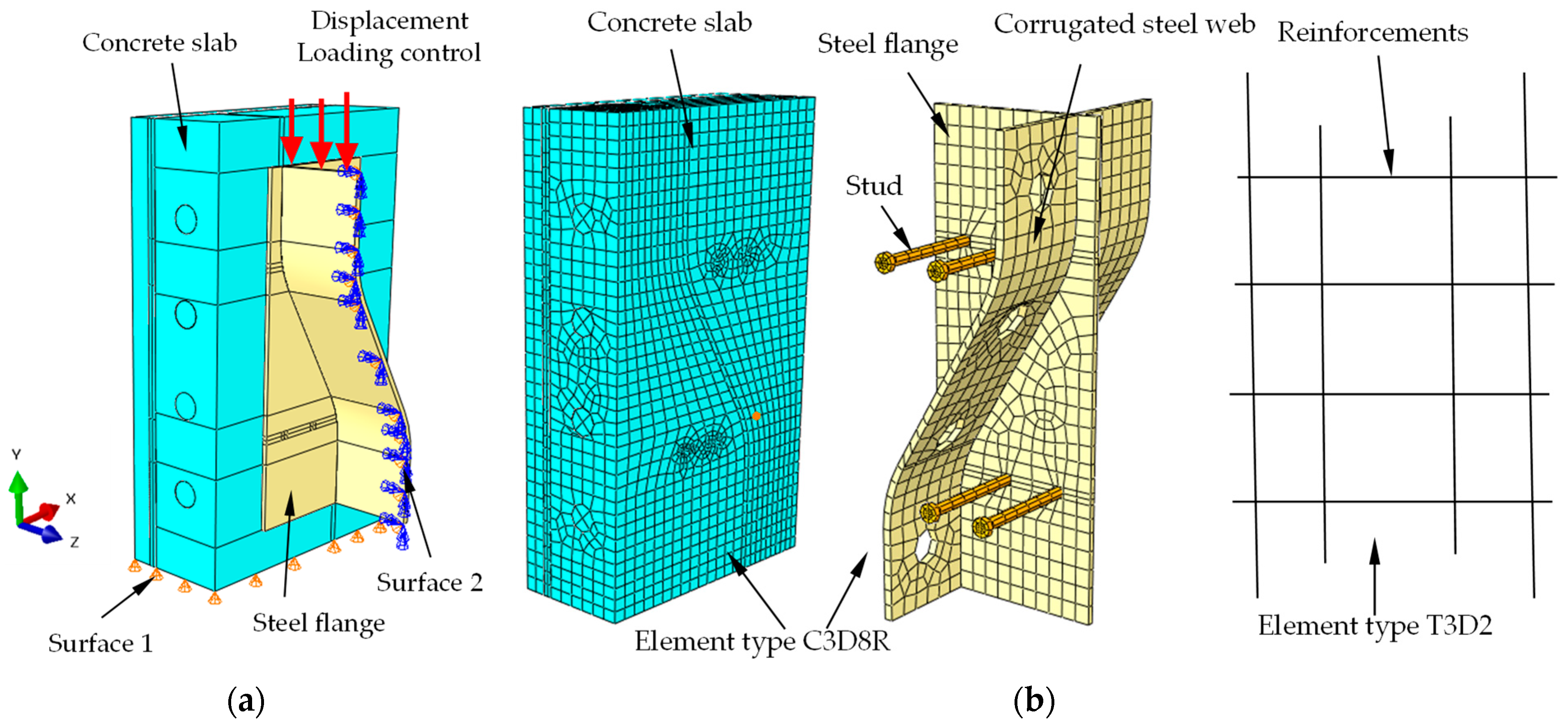
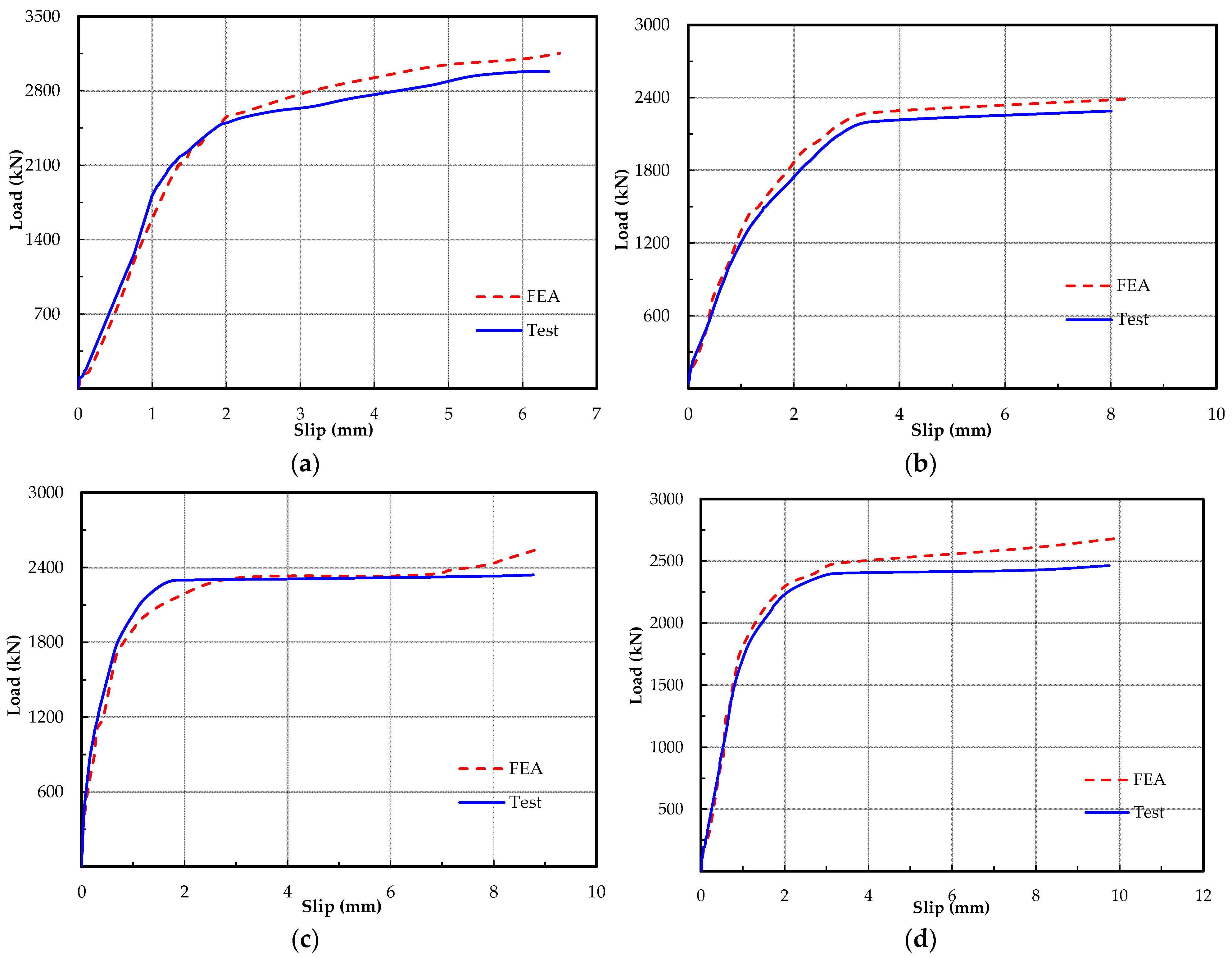
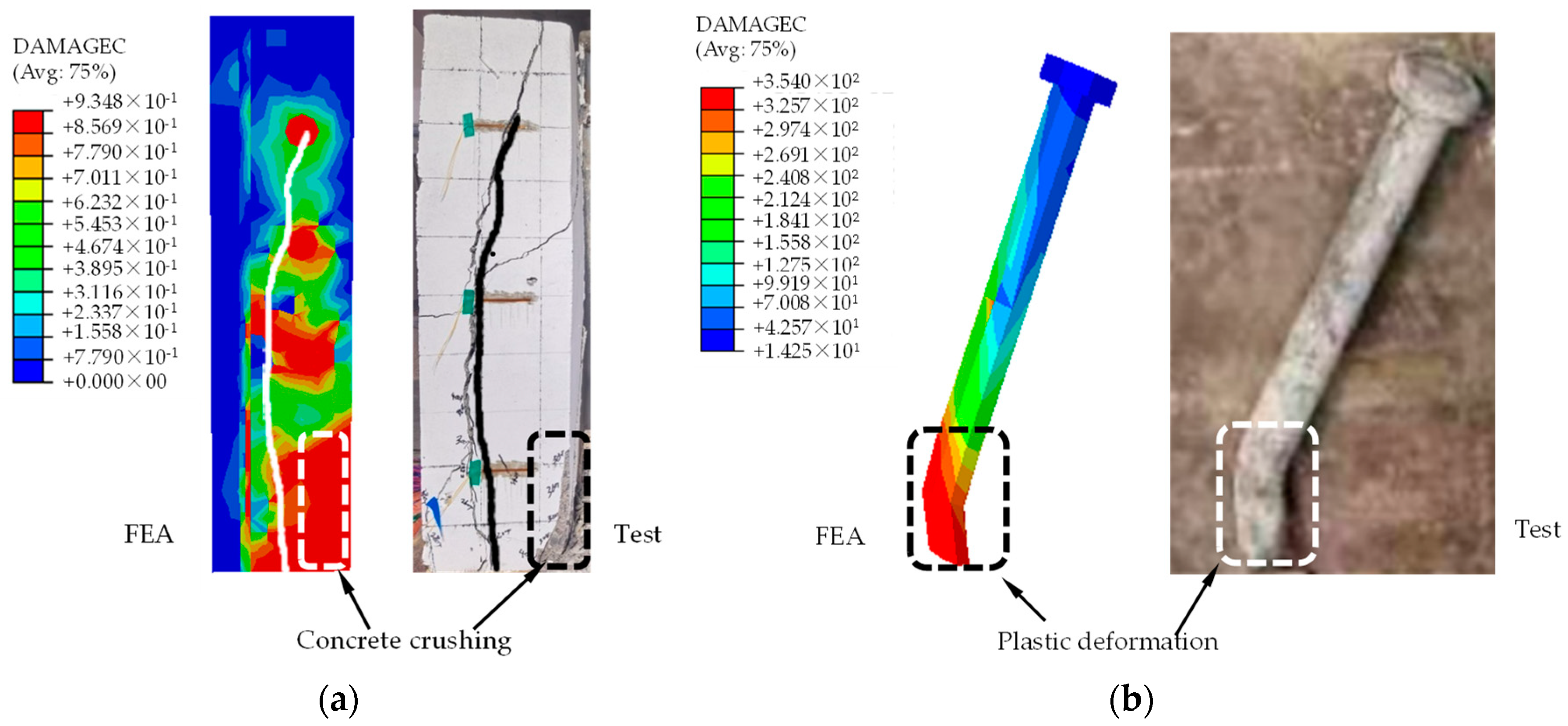
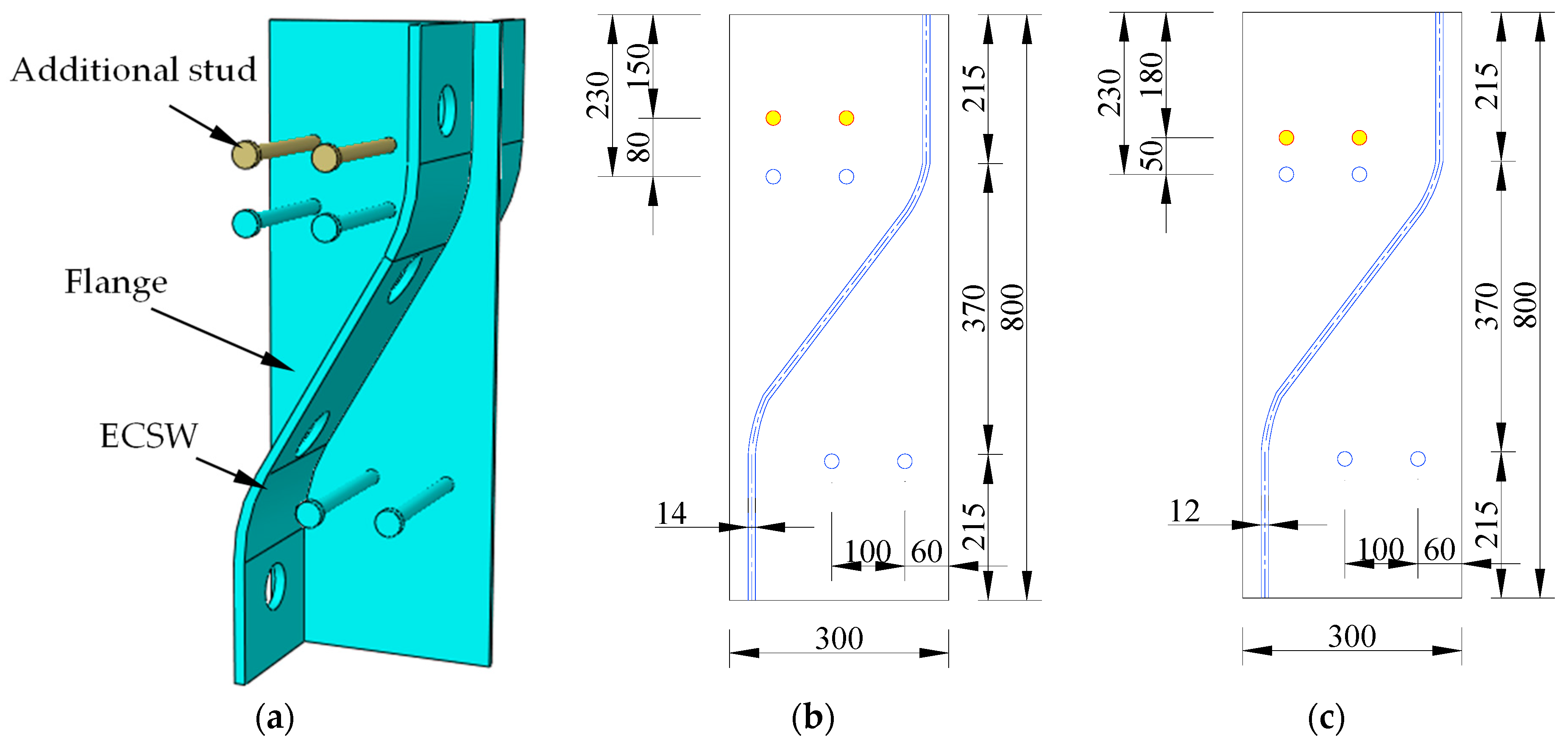

| Specimen No. | tf/mm | l/mm | tw/mm | d/mm | Stud |
|---|---|---|---|---|---|
| ESCF-SR1 | 8 | 180 | 14 | 22 | Yes |
| ESCF-SR2 | 10 | 180 | 14 | 22 | Yes |
| ESCF-SR3 | 12 | 180 | 14 | 22 | Yes |
| ESCF-SR4 | 10 | 180 | 12 | 22 | Yes |
| ESCF-SR5 | 10 | 180 | 14 | 16 | Yes |
| ESCF-SR6 | 10 | 210 | 14 | 22 | Yes |
| ESCF-SR7 | 10 | 150 | 14 | 22 | Yes |
| ESCF-SR8 | 8 | 150 | 12 | 16 | Yes |
| ESCF-9 | 10 | 180 | 14 | 22 | No |
| Material | Yield Strength (MPa) | Ultimate Strength (MPa) | Cubic Compressive Strength (MPa) | Elastic Modulus (GPa) |
|---|---|---|---|---|
| Rebar | 470.8 | 635.6 | - | 200.0 |
| Steel | 384.5 | 517.3 | - | 206.0 |
| Stud | 321.0 | 409.0 | - | 210.0 |
| Concrete | - | - | 57.3 | 35.5 |
| Specimen No. | S/mm | P0.2/kN | P/kN | k/kN·mm−1 | Failure Mode |
|---|---|---|---|---|---|
| ESCF-SR1 | 7.21 | 542 | 2021 | 2710 | LB |
| ESCF-SR2 | 7.34 | 351 | 2301 | 1755 | SC |
| ESCF-SR3 | 6.35 | 340 | 2982 | 1700 | SC |
| ESCF-SR4 | 8.01 | 344 | 2291 | 1720 | SC |
| ESCF-SR5 | 8.77 | 964 | 2340 | 4820 | SC |
| ESCF-SR6 | 9.75 | 397 | 2463 | 1985 | SC |
| ESCF-SR7 | 5.69 | 529 | 2492 | 2985 | SC |
| ESCF-SR8 | 15.84 | 277 | 2050 | 1385 | LB |
| ESCF-9 | 6.01 | 300 | 2004 | 1500 | LB |
| Specimen No. | P/kN | V1/kN | V1/P | V2/kN | V2/P | V3/kN | V3/P | V4/kN | V4/P |
|---|---|---|---|---|---|---|---|---|---|
| ESCF-SR1 | 2021 | 1224 | 0.61 | 1723 | 0.85 | 1649 | 0.82 | 1996 | 0.99 |
| ESCF-SR2 | 2301 | 1224 | 0.53 | 1723 | 0.75 | 1649 | 0.72 | 1996 | 0.87 |
| ESCF-SR3 | 2982 | 1224 | 0.41 | 1723 | 0.58 | 1649 | 0.55 | 1996 | 0.67 |
| ESCF-SR4 | 2291 | 1224 | 0.53 | 1723 | 0.75 | 1649 | 0.72 | 1996 | 0.87 |
| ESCF-SR5 | 2340 | 1179 | 0.50 | 1678 | 0.72 | 1649 | 0.70 | 1996 | 0.85 |
| ESCF-SR6 | 2463 | 1413 | 0.57 | 1995 | 0.81 | 1881 | 0.76 | 1948 | 0.79 |
| ESCF-SR7 | 2492 | 1035 | 0.42 | 1451 | 0.58 | 1417 | 0.57 | 2056 | 0.83 |
| ESCF-SR8 | 2050 | 1224 | 0.60 | 1723 | 0.84 | 1417 | 0.80 | 2056 | 1.00 |
| ESCF-9 | 2004 | 990 | 0.49 | 1406 | 0.70 | 1649 | 0.71 | 1996 | 1.00 |
| Average | - | - | 0.52 | - | 0.73 | - | 0.71 | - | 0.87 |
| Variation coefficient | - | - | 0.13 | - | 0.13 | - | 0.12 | - | 0.13 |
| Specimen No. | P/kN | Pu/kN | S/mm | Su/mm | Pu/P | Su/S |
|---|---|---|---|---|---|---|
| ESCF-SR1 | 2021 | 2193 | 7.3 | 8.0 | 1.08 | 1.09 |
| ESCF-SR2 | 2301 | 2512 | 17.2 | 18.2 | 1.08 | 1.05 |
| ESCF-SR3 | 2982 | 3154 | 6.3 | 6.5 | 1.05 | 1.03 |
| ESCF-SR4 | 2291 | 2388 | 8.0 | 8.3 | 1.03 | 1.03 |
| ESCF-SR5 | 2340 | 2538 | 8.7 | 8.8 | 1.08 | 1.01 |
| ESCF-SR6 | 2463 | 2684 | 9.7 | 10.2 | 1.08 | 1.05 |
| ESCF-SR7 | 2492 | 2730 | 5.7 | 6.1 | 1.08 | 1.07 |
| ESCF-SR8 | 2050 | 2247 | 15.8 | 16.0 | 1.08 | 1.01 |
| ESCF-9 | 2004 | 2208 | 6.01 | 6.5 | 1.10 | 1.08 |
| Specimen No. | tw/mm | l/mm | d/mm | Stud | Pu(kN) | Failure Mode |
|---|---|---|---|---|---|---|
| ESCF-SR1 | 14 | 180 | 22 | 4 | 2021 | Local buckling |
| ESCF-OSR1 | 14 | 180 | 22 | 6 | 2268 | Splitting crack |
| ESCF-SR8 | 12 | 150 | 16 | 4 | 2050 | Local buckling |
| ESCF-OSR8 | 12 | 150 | 16 | 6 | 2362 | Splitting crack |
Disclaimer/Publisher’s Note: The statements, opinions and data contained in all publications are solely those of the individual author(s) and contributor(s) and not of MDPI and/or the editor(s). MDPI and/or the editor(s) disclaim responsibility for any injury to people or property resulting from any ideas, methods, instructions or products referred to in the content. |
© 2024 by the authors. Licensee MDPI, Basel, Switzerland. This article is an open access article distributed under the terms and conditions of the Creative Commons Attribution (CC BY) license (https://creativecommons.org/licenses/by/4.0/).
Share and Cite
Zhang, Z.; Jin, W.; Deng, E.; Yu, C.; Wan, W.; Duan, C.; Zhang, L.; Wang, S. Shear Behavior and Design of Innovative Stud-Reinforced Embedded Shear Connectors with Flanges. Buildings 2024, 14, 632. https://doi.org/10.3390/buildings14030632
Zhang Z, Jin W, Deng E, Yu C, Wan W, Duan C, Zhang L, Wang S. Shear Behavior and Design of Innovative Stud-Reinforced Embedded Shear Connectors with Flanges. Buildings. 2024; 14(3):632. https://doi.org/10.3390/buildings14030632
Chicago/Turabian StyleZhang, Zhe, Wenhao Jin, Enfeng Deng, Chenyang Yu, Weidong Wan, Changzhi Duan, Lian Zhang, and Shibo Wang. 2024. "Shear Behavior and Design of Innovative Stud-Reinforced Embedded Shear Connectors with Flanges" Buildings 14, no. 3: 632. https://doi.org/10.3390/buildings14030632
APA StyleZhang, Z., Jin, W., Deng, E., Yu, C., Wan, W., Duan, C., Zhang, L., & Wang, S. (2024). Shear Behavior and Design of Innovative Stud-Reinforced Embedded Shear Connectors with Flanges. Buildings, 14(3), 632. https://doi.org/10.3390/buildings14030632






